|
|
|
Sort Order |
|
|
|
Items / Page
|
|
|
|
|
|
|
| Srl | Item |
| 1 |
ID:
180095
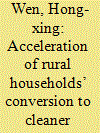

|
|
|
|
|
| Summary/Abstract |
This study investigated the existence of peer effects in the diffusion of clean cooking fuels among rural households in China and identified the mechanisms by which these peer effects were enacted from the perspective of social networks. We observed greater adoption of clean cooking fuels in areas in which adoption was already relatively high, however, this peer spill-over decreased over time and was regulated by the accessibility and strength of social networks. Specifically, if a household's social circle was more extensive or its communication with neighbours, relatives, and friends was closer, its choice of a clean cooking fuel was more likely to be affected by its peer groups. To stimulate stronger peer spill-over, we suggest that interventions such as strengthening social interactions across rural households should be included in the government's strategy to help more households convert to cleaner cooking fuels.
|
|
|
|
|
|
|
|
|
|
|
|
|
|
|
|
| 2 |
ID:
112716
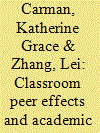

|
|
|
|
|
| Publication |
2012.
|
| Summary/Abstract |
This paper estimates peer effects on student achievement using a panel data set from a middle school in China. Unique features of the organization of Chinese middle schools (Grades 7 to 9) and panel data allow us to overcome difficulties that have hindered the separation of peer effects from omitted individual factors due to self-selection and from common teacher effects and to identify peer effects at the classroom level. We estimate peer effects for Math, English, and Chinese test scores separately. In a linear-in-means model controlling for both individual and teacher-by-test fixed effects, peers are found to have a positive and significant effect on math test scores, a positive but insignificant effect on Chinese test scores, but no effect on English test scores. Importantly, in Math and Chinese students at the middle of the ability distribution tend to benefit from better peers, whereas students at the ends of the ability distribution do not, suggesting that policy makers who want to exploit positive peer effects face difficult tradeoffs in classroom and school assignment.
|
|
|
|
|
|
|
|
|
|
|
|
|
|
|
|
| 3 |
ID:
170109


|
|
|
|
|
| Summary/Abstract |
This paper examines peer effects on the academic performance of rural migrant students at both the class level and the individual level. The dataset is from a survey of more than 3000 students from all of the 87 migrant schools in Shanghai and Suzhou, China. The two-stage least squares method with an instrumental variable is employed to control for the endogeneity of peer performance variables. We found that peer effects exist among the migrant students at both class and individual levels. A one-point increase in the average of standardized math grade (SMG) of his/her classmates is associated with an increase of 0.5 points in the SMG of an individual (1.01 standard deviation). A one-point increase in a learning companion's SMG can result in an increase of 0.046 points in the student's SMG. The findings reveal that private migrant schools can improve rural migrant students' academic performance by optimizing students' class allocation and building study groups, providing an additional boost to the input-output efficiency of the human-capital education of the children of migrant workers in China, but the effects of these measures are limited.
|
|
|
|
|
|
|
|
|
|
|
|
|
|
|
|
| 4 |
ID:
147618
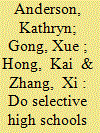

|
|
|
|
|
| Summary/Abstract |
We use regression discontinuity design to examine the effect of a system of public exam high schools, which admit students solely by pre-existing achievement, on student college entrance exam scores in Beijing, China. More selective exam schools may have higher peer quality and sometimes are equipped with more experienced teachers and better facilities. We find, however, that elite exam high schools, which are the most selective, have no effects on student test scores. We find that on average the system of exam schools improves student performance on the exam, which indicates that students benefit from attending more selective non-elite schools. The results on qualifying for college admission are consistent with our findings about test scores. Differences among schools in peer achievement, student/teacher ratio and the percentage of certificated and experienced teachers partially explain our findings; self-choices of track and exam participation do not explain test scores or college admission.
|
|
|
|
|
|
|
|
|
|
|
|
|
|
|
|
| 5 |
ID:
168349


|
|
|
|
|
| Summary/Abstract |
Employing a unique data from a county in rural China, we use the regression-discontinuity design to study the causal effects of elite school and magnet class enrollment. Our data contains two admissive processes, allowing us to separately examine elite school and magnet class effects on two groups of students with different abilities. Results show that enrollment in elite schools has small and insignificant effect on borderline student scores in the college entrance examination, whereas studying at a magnet class can significantly boast borderline student CEE score by 0.435 standard deviations. We provide suggestive evidence that teacher effect is roughly 40% of the magnitude of the peer effects associated with the score gain in magnet classes. We also find magnet class experience can improve the probability of entering high-quality academic universities. By comparing the effects of two cutoffs with different student abilities, our findings support the claim that the effect of elite school/magnet class enrollment depends on student abilities.
|
|
|
|
|
|
|
|
|
|
|
|
|
|
|
|
| 6 |
ID:
124559
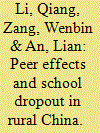

|
|
|
|
|
| Publication |
2013.
|
| Summary/Abstract |
This paper attempts to identify neighborhood peer effects on children's dropout decision in rural China using the China Health and Nutrition Survey data (CHNS). Identifying peer effect is complicated by several endogenity problems including "self-selection" problem, "reflective" problem and uncontrolled "correlated effect". By taking advantage of the special feature of "Hukou" system and "son preference" phenomenon in rural China, the endogenity issues are quite reasonably addressed. More specifically, we discover a new and valid instrumental variable for peer's dropout rate: peers' firstborn boy rate. Intuitively, the more the firstborn boy peers, the lower the peers' dropout rate because of son preference and the lower one's own dropout probability due to peer effect. It is found that as peers' dropout rates increase by one percentage point, the child dropout rate would increase by 0.393 to 0.504 percentage points, the corresponding social multiplier effects of peer dropout are from 1.647 to 2.016. It is also found that elder kids and females are more susceptible to peer pressure in dropout decisions. Many other interesting findings are documented.
|
|
|
|
|
|
|
|
|
|
|
|
|
|
|
|
| 7 |
ID:
187861
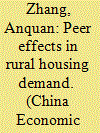

|
|
|
|
|
| Summary/Abstract |
This paper utilizes data from the China Household Finance Survey 2011 to study peer effects in housing demand in rural China. We find that focal households' housing consumption is heavily influenced by peer households' housing consumption. Evidence from placebo tests, IV estimates and robust tests suggests that the relationship is causal. In addition, we show that status seeking and social learning play important roles in determining peer effects in the demand for rural houses. Finally, we explore the heterogeneity in peer effects and determine that the leading mechanism is status seeking.
|
|
|
|
|
|
|
|
|
|
|
|
|
|
|
|
| 8 |
ID:
143388
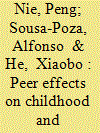

|
|
|
|
|
| Summary/Abstract |
Using data from the China Health and Nutrition Survey (CHNS), this study analyzes peer effects on obesity in a sample of 3- to 18-year-old children and adolescents in China. Even after a rich set of covariates and unobserved individual heterogeneity are controlled for, it is evident that such peer effects do indeed exist. These effects are stronger in rural areas, among individuals at the upper end of the BMI distribution, and especially among females. All else being equal, female adolescents whose peers have a higher BMI are less likely to consider themselves overweight, suggesting that peer effects may be working through changed societal bodyweight norms.
|
|
|
|
|
|
|
|
|
|
|
|
|
|
|
|
| 9 |
ID:
128362


|
|
|
|
|
| Publication |
2014.
|
| Summary/Abstract |
Solar Community Organizations (SCOs) are formal or informal organizations and citizen groups that help to reduce the barriers to the adoption of residential solar photovoltaic (PV) by (1) providing access to credible and transparent information about the localized benefits of residential PV and (2) actively campaigning to encourage adoption within their operational boundaries. We study the peer effect, or social interaction, process catalyzed by SCOs to understand the impact of these organizations on the residential PV market. Using a standardized search methodology across spatial scales (state; city; neighborhoods), we identify and characterize the operations of 228 SCOs formed in the U.S. between 1970 and 2012. We also present case studies of four successful SCOs and find that a common thread of why these SCOs are successful involves effectively leveraging trusted community networks combined with putting together a complete information and financial-tools package for use by interested communities. Finally, our findings suggest that empirical studies that attempt statistical identification and estimation of peer effects should pay close attention to the role of SCOs, as the social interactions engendered by SCOs may be correlated both with the level of social learning and the socio-demographic characteristics of the communities of interest.
|
|
|
|
|
|
|
|
|
|
|
|
|
|
|
|
| 10 |
ID:
177449


|
|
|
|
|
| Summary/Abstract |
Spatial spillovers – peer effects from neighboring actions on one's own decisions – play an important role in the diffusion of technologies, particularly the adoption of residential photovoltaic (PV) systems and have important implications for renewable energy policies meant to encourage small-scale solar energy generation. Existing research notes spillovers manifest at large spatial scales but evidence at smaller scales is currently absent. In this work, we examine if spatial spillovers in residential PV system adoptions exist at small scales – specifically within one's nearest set of neighbors – using spatially explicit data on residential PV installations from Baltimore, MD. We find strong evidence for the existence of spatial spillovers, with a neighboring installation increasing PV system adoption likelihood by 16.5–17.1 percent. The results indicate the presence of a potential multiplier effect that can be targeted by policymakers interested in encouraging solar energy development to meet renewable energy goals.
|
|
|
|
|
|
|
|
|
|
|
|
|
|
|
|
|
|
|
|
|